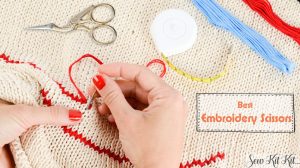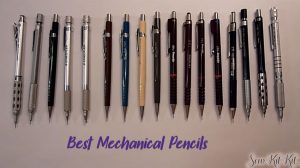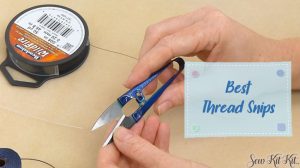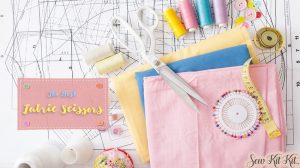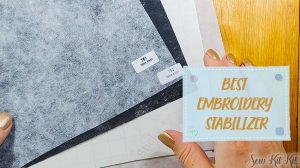Last Updated on January 10, 2023
Are you looking for the best rotary cutters for your fabric cutting projects? Here is our complete guide!
When you buy through links on our site, we may earn an affiliate commission. As an Amazon Associate I earn from qualifying purchases.
There was a time when the sewers and quilters could not imagine an alternative to scissors. Time has changed and the ingenious rotary cutters have taken the place of scissors for their super-fast cutting ability with minimum efforts. This article is for you if you are searching for the best rotary cutter for your sewing, quilting, or crafting projects.
I have already said that it is not possible to choose a rotary cutter as the best cutter for all. You have to choose it according to your need and convenience.
Here are some of the best rotary cutter reviews for the convenience of comparing and choosing.
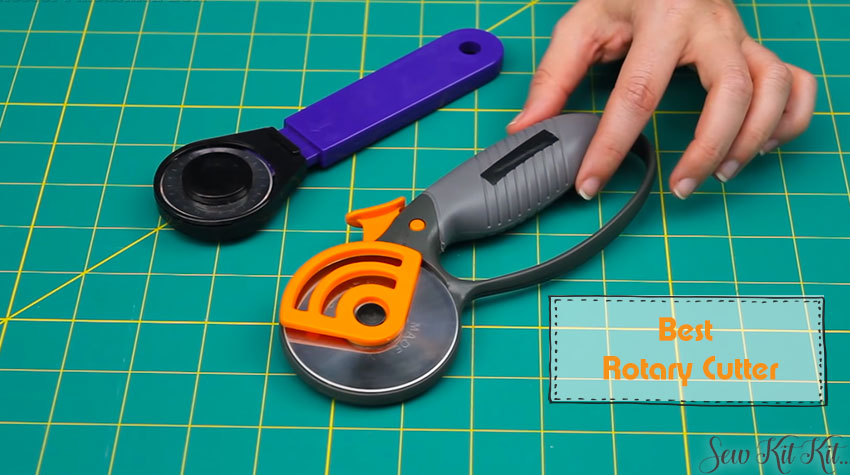
The 8 Best Rotary Cutters
| Image | Title | Buy |
|---|---|---|
 Top
Top | Fiskars Sewing Essentials Set (6pc), Orange 6 Count | Check Price! |
 Top
Top | Fiskars 01-005828 Titanium Comfort Stick Rotary Cutter, 45 mm | Check Price! |
 Top
Top | OLFA RTY-2/C 45mm Splash Rotary Cutter,Aqua | Check Price! |
 Top
Top | Hercules HRK-100 5-Speed Electric Rotary Cutter for Cloth, Leather, Natural and Synthetic Fabrics – 4 Inch Single & Multi-Layer Round Knife Cutting Machine – 110 Volt AC | Check Price! |
 Top
Top | Fiskars Classic (45mm) Comfort Loop Rotary Cutter, 1, steel and orange | Check Price! |
 Top
Top | OLFA Rotary Circle Cutter | Check Price! |
 Top
Top | Headley Tools 45mm Rotary Cutter with 5pc 45mm Rotary Blade (Pack of 6) for Quilting Fabric and Arts & Crafts (Pink) | Check Price! |
 Top
Top | BONROB 45mm Rotary Cutter, with 7 Replacement Rotary Blades for Crafting, Quilting, Sewing BO005 | Check Price! |
1. Fiskars 195210-1001
- This all-in-one, 6-piece Fiskars Sewing Essentials Set gives you the tools you need to enhance your sewing kit
- Original Orange-handled Scissors (8 in. ) cut all the way to the tip and feature high-grade, precision-ground, stainless steel blades for a lasting sharp edge
- Thread Snips (5 in. ) feature pointed tips for quick, precise snips on loose ends, thread, floss, yarn and other lightweight materials
- Use the Acrylic Ruler and Measuring Tape for precise measurements, the Sewing Gauge to lock them in, and the Seam Ripper to undo stitches
- Full lifetime (excludes Measuring Tape and Seam Ripper)
If you do a lot of cutting, it can be a great assistance for you. Can cut through cotton, flannel, fleece, batting, paper, jersey, vinyl, etc.
The cutter is designed in a curved shape with a loop handle to fit your hand naturally and comfortably for better control and cutting experience so you will enjoy fatigue and pain-free cutting in comparison to scissors. Comes with safety features to avoid accidental cuts. Lightweight, so easy to hold for a long period.
The handle feels ergonomic in your hands and comfortable to hold and use, even though it’s all hard plastic and nothing fancy. The 45 mm premium steel blade that comes with the cutter is very sharp and durable. cuts through fabrics like butter. spandex and even tougher materials like vinyl and cotton canvas
The blade comes configured for a right-handed user, but if you’re a lefty, you can easily unscrew the blade and put it on the other side of the cutter.
If you’re right-handed, this is definitely a good rotary cutter to start with, but if you’re left-handed, you may want to spend some more time searching for a more lefty-friendly design.
This rotary cutting tool is great at cutting long, smooth curves. It is easy to cut a straight line using a ruler and takes minimal effort to cut the material. You have to make sure that the blade is aligned with the ruler for straight cutting and always use it on a special cutting board. It cuts through multiple layers of fabric with ease and without frayed edges.
Push the lever on the back of the cutter to bring the blade into position for cutting. Finish your cut and push the button on the side to retract the blade inside.
Replace the blade when needed. Keep additional blades for use.
The blades can wobble sometimes which will affect your control. Tighten the nut. Retractable so you do not worry about your toddlers.
2. Fiskars 01-005875 Titanium Rotary Cutter
- Ideal for cutting multiple layers of fabric, paper, felt and vinyl
- Premium steel 45 mm rotary blade features a titanium coating that is 3X times harder than steel for improved durability and lasting sharpness
- Ergonomically sculpted handle with Softgrip provides added comfort
- A symmetrical design makes freehand cutting easy for right- and left-handed users
- Full lifetime warranty (excludes blad
Can cut thicker fabric, batting, foams. Glides through multiple layers of fabrics at a time. For smaller curves use a smaller diameter blade. The blade can be assembled to either side of the rotary cutter. Precision-ground 60mm titanium rotary blade that is more durable and sharper.
Lightweight and easy to grip. Soft and non-slip rubber grip. Comfortable for multiple hand sizes. For left-handed users swapping the blade over is quick and easy. The ergonomic design enables you to cut fabrics for longer periods of time. No fatigue or aching. There may be some small wobble but give consistent pressure on a ruler to get a straight enough cut.
Can bite off your fingers or knuckles when keeping the fabric in place while cutting. So be cautious while operating. Doesn’t require you to put some sort of cover over it to protect it or yourself if it falls off the table or something, it just pops right into place with the push of the orange button on the side!
3. Olfa Splash Rotary Cutter Aqua 45mm
- Vibrant aqua handle color is as expressive as the person using it
- Contoured handle allows for comfortable cutting
- Integrated grooves at head of cutter help prevent finger slippage
- Blade cover for extra safety
- Includes and fits OLFA 45mm rotary bla
The wheel spins freely without much effort giving you precise cuts and beautifully clean lines. You will like the ability to utilize it from a variety of angles and not being restricted by a blade guard. Will allow you to cut many more fabric pieces than I would normally be able to cut using another rotary cutter that has a restricted cutting angle. No fatigue or numbness in hand and fingers or arm pain.
The blade is sharp and durable. Cut like butter through 6 layers with just one swipe. A new system to replace the blades without tools. Works beautifully for both right or left-handed.
The straight handle gives an easy grip. Integrated grooves let the cutter prevent finger slippage. It is balanced and secure. Lightweight so easy to operate. Sharp and makes precise cuts. Cut through multiple quilt layers perfectly.
Just retract the guard and push, the solid handle puts just the right amount of force behind your push making beautifully clean lines. The safety mechanism makes it really easy to put the blade away when not in use. Color is a bonus.
4. Hercules hrk-100 5-Speed Octagonal Rotary Cutter
- 💪 The HRK-100 is a 5-speed, 110 volt AC, electric rotary cloth cutting machine that cuts leather & multiple layers of fabric and cloth.
- 💪 4 inch high-speed octagonal blade with built-in sharpening stone..
- 💪 The octagonal blade and carbide-tipped, spring loaded lower blade prevents the fabric from jamming.
- 💪 Best used for light to medium weight cloth and fabrics, woven or loosely knit fabric.
- 💪 Cuts cotton, silk, synthetic fiber, leather and other materials, fabrics and clo
Electric rotary cloth cutting machine and cuts leather & multiple layers of fabric and cloth, jeans, Can cut cotton, silk, synthetic, leather and other materials. It is not for a single ply of fabric or ultra-lightweight fabric unless the paper is used on the top and bottom.
It’s not intended for heavy use, so if you’re looking for something industrial-strength, try a more expensive cutter. This is lighter and easier to handle, the handle is rubber padded. You will not have shoulder or wrist pain though you work for a long time.
Has built-in sharpener stone so the blade will be sharp for a long period. This thing cuts through layers (5-6) of denim and leather with no problems. But it doesn’t cut around tight corners or curves easily. The spring-loaded lower blade prevents the fabric from jamming.
Sometimes it starts with extra speeds, have to cycle through a couple of times and listen to the motor sound to get the correct speed. The blade guard sometimes must be lifted to cut thick material, therefore, the blade is exposed and extremely sharp.
The cord is short. The safety guard comes down too low, it has to be up when this is in use. The sounds created at the time of cutting are very loud. If you do most of the sewing at night, it will be a disturbing fact for your family.
5. 45mm Contour Rotary Cutter
- Fashion Classic Loop Rotary Cutter features high-grade, precision-ground, 45 mm premium steel rotary blade for long-lasting sharpness
- Curved, loop-handle design provides a natural fit for your hand, improves control and lets you keep the cutter in hand while you rearrange materials
- Sliding button extends blade during use, locks it into position and retracts it for safe storage
- Ideal for cutting multiple layers of fabric, paper, felt and vinyl, the blade can be assembled to either side for both right- and left-handed users
- Full lifetime warra
Perfect for cutting multiple layers of fabric, paper, felt and vinyl, etc.
Design with a dual-action safety lock allows for the blade to be locked when not in use.
The rotary blade can be assembled to either side of the rotary cutter so both the right-handed and left-handed persons can use it. The blade is very sharp and it is easy to hold and cut multiple layers of fabric and paper.
Fantastic to use and no fear that your child will cut themselves due to forgetting to close the blade.
The handle is designed to reduce joint fatigue and pain and gives you a comfortable grip. So, you can use it for a long time.
Use it lowering the blade and then releasing it raises so it’s never put down with the blade exposed. Nice built-in safety feature to the handle to lock the blade in place when not in use. A razor-sharp blade that cuts through fabric effortlessly. Simple yet functional design.
Not for a big project.
6. OLFA Rotary Circle Cutter
- Effortlessly cut perfect circles from 1-1/2 to 8-3/4
- Patented ratchet handle aligns the hand and wrist to help reduce wrist fatigue
- Handle design creates a stirring the soup cutting motion, preventing uncomfortable twisting or strain on the wrist
- Built-in blade cover and plastic pivot spike guard for safety when not in use
- Includes and fits the OLFA 18mm rotary bl
Cuts through felt (the cheap kind), fleece, and cotton fabric efficiently. Does not work well with denim. It takes a little practice to work out perfectly.
Whether you’re right- or left-handed, you can easily cut clean and precise circles with this circle cutter.
So faster, no problems with the fabric slipping. If you are using thicker pages, you better stick to one at a time.
The product is well made and the cutter is really sharp and the one-way-bezel handle spins smoothly.
But, the bigger the circle the better chance of messing up or your wrist getting tired after doing 100 of these in a sitting. If your project demands last, it will be no problem. Anyway, Save a ton of time.
The pin that anchors the center of the circle is sturdy, yet makes only the smallest hole in the material you are working with.
The cylindrical handle has a ratchet feature which is really nice so you don’t have to reposition your hand and can keep constant pressure on the tool.
Felt and the heavy fabric are fine, but cotton sometimes tends to shift. Make sure you really dig that middle pin into the board or it will move. Press down firmly.
7. Rotary Cutter, Improved
- Headley Tools Rotary Cutter-- Ergonomically designed handle with soft-grip for comfort on both sides,,the Blade is made from SKS 7 steel, it is pin-sharp and durable.This will help to save time, while providing layered paper, fabric, vinyl and leather, and so on Schneiden.
- Blade folds away nicely and safely, when trigger handle is released. Once the safety locking button is set, the trigger handle cannot be used.This handy rotary cutter is designed with a safety button to lock the blade. Even a kid can use it safely under the supervision of his/her parents!
- Perfect for Cutting Fabric, Quilts, Thread, Paper, and More! Its Ideal for Quilters, Sewing, Scrapbooking, Card Making, and other DIY Projects!
- Rotary blade is made from high quality of SKS steel with is super sharp and durable.
- 100% MONEY BACK GUARANTEE - No questions asked. We stand by our products. If you feel that our product is not up to standard, please return for a full ref
Cut through thick stacks of fabric and multiple layers at a time. It also cuts spandex fabric. You can straight lines and curves, long strips, or small quilting squares very fast and get clean and precise cuts every time.
Lightweight so easy to operate. The handle is designed for comfort and the blade can be removed and reversed for left or right-handed use. Can effortlessly go through the material. So you will not have aching in your hands or wrist working for a long period.
Comes with a very sharp 45mm Titanium blade which will give you a smooth cutting and stays sharp for a long time. The blade isn’t exposed until you squeeze the handle. It stays safely retracted when the grip handle is released. The price is also very reasonable.
8. BONROB Rotary Cutter
- REPLACEABLE - The blade of 45mm rotary cutter is replaceable. Every rotary cutter with 7 extra blades, 4 for straight line cutting; 2 for curve cutting; 1 for dotted line cutting.
- SAFE - The craft rotary cutter is designed with a safety button to lock the blade. Also the blades can be installed on both side of the rotary cutter, perfect for both right- and left-handed users.
- PRECISE - The 45 mm blades are made of SKS-7 steel, sharp and hardly dull. With different replacement blades, you can cut multiple layers of fabric, paper or other materials precisely with the help of sewing cutters. The maximum cutting thickness is 5 mm.
- VARIABLE:FITS WITH ALL 45MM ROTARY CUTTER - Including Fiskars, Olfa, Truecut, Martelli, and most 45mm Rotary Cutters.blades rotary cutter with anti-slide handle is ergonomically designed to reduce joint fatigue.
- Use tips:When you press the button,pls make sure the button at same horizontal with the rotary cutter itself,then you can adjust the handle freely;If you want change blades,pls adjust the button with BONROB to the appropriate tightness,otherwise the blade will be hard to reach o
Comes with 6 extra replacement blades,3 of them are for straight-line cutting; 2 for curve cutting; 1 for dotted line cutting. The blades can be installed on both sides of the rotary cutter so both right- and left-handed users can use them. For quilting, sewing, scrapbooking, crafting, etc. Cuts multiple layers through the fabric, paper, and other materials. Cuts accurately with no skips.
The handle is very comfortable to use for a long time. Ergonomically designed to reduce joint fatigue. It cuts layered fabric easily without applying a lot of pressure. Designed with a safety button to lock the blade back. So, it will keep the cutter safe when not in use.
The additional blades that ship with this cutter is a bonus, but nothing special in terms of quality and performance. Blade dulls fast. So, if you purchase separate titanium-coated blades, the combination of this cutter with them will deliver you precise, consistent, and arthritis-friendly cuts consistently. For the affordable price with all that extra blades, ease of use, and fairly comfortable grip this fabric cutter is an excellent value.
What is a rotary cutter?
A rotary cutter is a tool used by quilters and sewers to cut straight lines of fabric with a circular rotating blade attached to a handle. It can cut through multiple layers of fabrics at a single swipe which enables a quilter very fast and easy cutting of hundreds of patterns of the same sizes with minimal stress.
Works on a variety of materials including very thick fabrics, paper, leather, etc. Needs a rotary cutting mat and at least ¼ thick transparent ruler to work with.
A rotary cutter is available in varieties of models based on different blade sizes, different handles (straight, curved, padded, or ergonomic), and different safety features. Smaller blades are for cutting small curves and intricate cuts, larger blades are for cutting straight lines and large curves.
How to Choose the Best Rotary Cutter
It was not long ago when a quilter has very few choices while buying a rotary cutter. But, now there are hundreds of brands and models of this tool from which you can choose the type that will suit your needs and working capacity. Which rotary cutter will be best for you depends on what you are going to cut, what type of handle you prefer, whether safety feature is a significant consideration for you or not etc.
Here are the factors that you should notice for choosing the most suitable and comfortable rotary cutter for your projects.
Size
Rotary cutter blades come in different sizes. The most common sizes are 18mm, 28mm, 45mm, and 60mm. Larger blades are for faster cutting. They can cut several layers of fabric. The smaller blades are for curving and intricate cuts.
For long, straight cuts you should use 60mm blades. 45mm is the most effective size. They can be used for cutting shapes, strips, quilting, etc. 18mm and 28mm cutters are for intricate cuts and tight corners.
Handle
If you do a lot of cutting with your rotary cutter, the issue of comfort comes first in your consideration list. You should consider a handle that will give you the most comfortable grip. There has been done a lot of experiment for the convenience of the users. You will find straight handles, curved handles, padded handles, ergonomic handles, etc. Some rotary cutters are made considering the problems of arthritis and other hand and wrist issues.
Safety feature
As rotary blades are extremely sharp, it is very normal to accidentally cut your hands or injure your legs. And if you have small toddlers in your house, the risk arises on a large scale.
Therefore, the safety feature is a very important consideration for buying rotary blades. Most of the rotary cutter brands have the safety feature, but the type of safety latch is different and if you have limited mobility issues, you will face problems while operating the cutter.
In most rotary cutters the safety latch has to be manually retracted and put back before and after use. But some manufacturers have brought the auto-retractable blades so you need not worry about remembering to close the guard.
Material
The material of the rotary cutter is either steel or titanium. Steel blades are cheap. Most of the rotary cutter blades are made of steel. Some brands use titanium blades which costs more than steel blades. They are durable and good for long use.
Alternative blades
If your projects demand alternative blade cuts there are some options for you. You can buy Wave, Scallop, and peak and pinking blades rather than only normal straight blades. They will fit onto your regular rotary cutter. You have to just swap the blades for trimming and decorative designs.
How to use a rotary cutter and mat
To cut your fabric using your rotary cutter you have to follow these steps-
Layout your fabric on the mat
Put your rotary mat on the table. Layout your fabric on the mat. Smoothen the wrinkles. For best result iron it. Align the mat to take measurements from the horizontal and vertical edges. Your fabric shouldn’t cover over the numbers of the edges of the mat.
Line up the ruler with the fabric
Position the ruler over your fabric. The ruler’s edge should line up with the starting point of the cutting and the grid markings on the mat. Press the ruler firmly.
Open the blade and position it against the edge of the ruler. Give consistent downward pressure on the cutter and push it onward to the fabric.
Repeat the same process for the other edges
Turn the other side of the fabric and align the ruler to the new edge. Set up the ruler in the same way and cut it as you want. When you are done with it, retract your blade for safety.
Shut the safety cover
When you are done with cutting, shut the safety cover immediately to avoid any kind of accident. The uncovered blade can be accidentally dropped on the floor resulting in decreasing its ability to cut or directly falling on your bare legs…. you can imagine the rest!
Scissors vs. Rotary cutter
Scissors have two handles of the same size. Scissors are versatile to cut out garments, sewing patterns, trim excess fabric from seam allowances, snip loose threads. They can easily cut curves.
Rotary cutters are for quick and effortless cutting. You can easily cut long straight lines or curved lines, intricate and precise cuts with them.
Can be used in quilting, sewing, crafting, and so on. The main thing is they can cut multiple layers of fabric at one swipe which scissors can’t. If you have arthritis or hand or wrist issues you will feel more comfortable cutting with a rotary cutter and you can cut for a long time with no issues.
Some tips to work with a rotary cutter
Cut with a sharp blade for easy and fast cutting. A dull rotary cutter will not give you a clear cut, you have to give more pressure and the chance of missed cuts and slip-ups will be increased. It can damage your mat also.
Cut with a rotary cutter standing by your cutting table. It will give you a better view and ensure your body weight to pressurize the cutter to cut a firm and secure piece.
Always cut away from your body to avoid the risk of accidentally running it over your hand or body parts. Do not pull the cutter towards your body.
People also ask
What is a self-healing mat?
A self-healing cutting mat is a flexible and thinner cutting surface that is made from very small individual pieces. The scratches created on the mat by rotary cutting blades reclose afterward. Thus, it is named so.
Should I use rotary rulers with rotary cutters?
Normal rulers which are not designed for rotary cutters will not work as well as rotary rulers. They have also angle marking on them for cutting bias strips and shapes. They are at least ¼ inches thick to provide a barrier between your hands and the cutter.
Is a rotary cutter and a pizza cutter the same?
Rotary cutters look like pizza cutters. But the difference is that a rotary cutter blade is extremely sharp so they can cut through several layers of fabric in one swipe.
Now you are ready with all the information needed for buying the best rotary cutter. Go to the store and choose this ingenious helping tool for stress-free cutting time.

